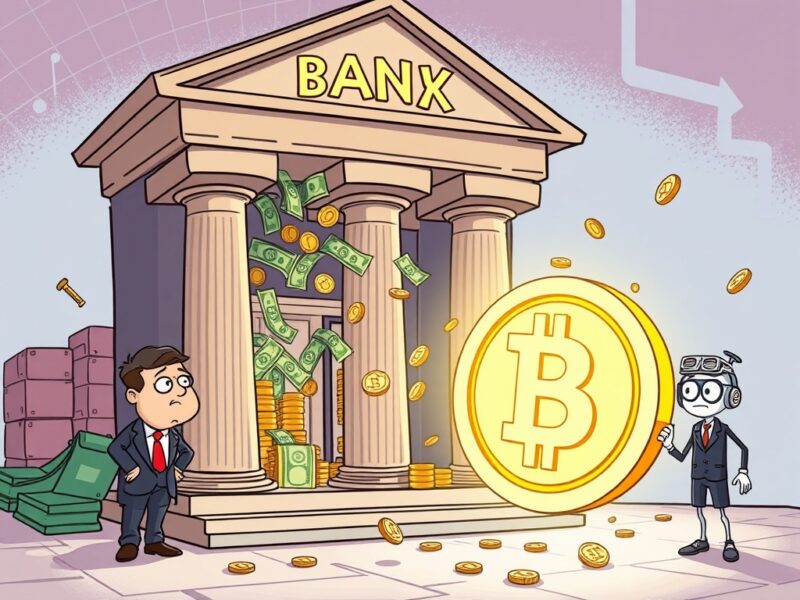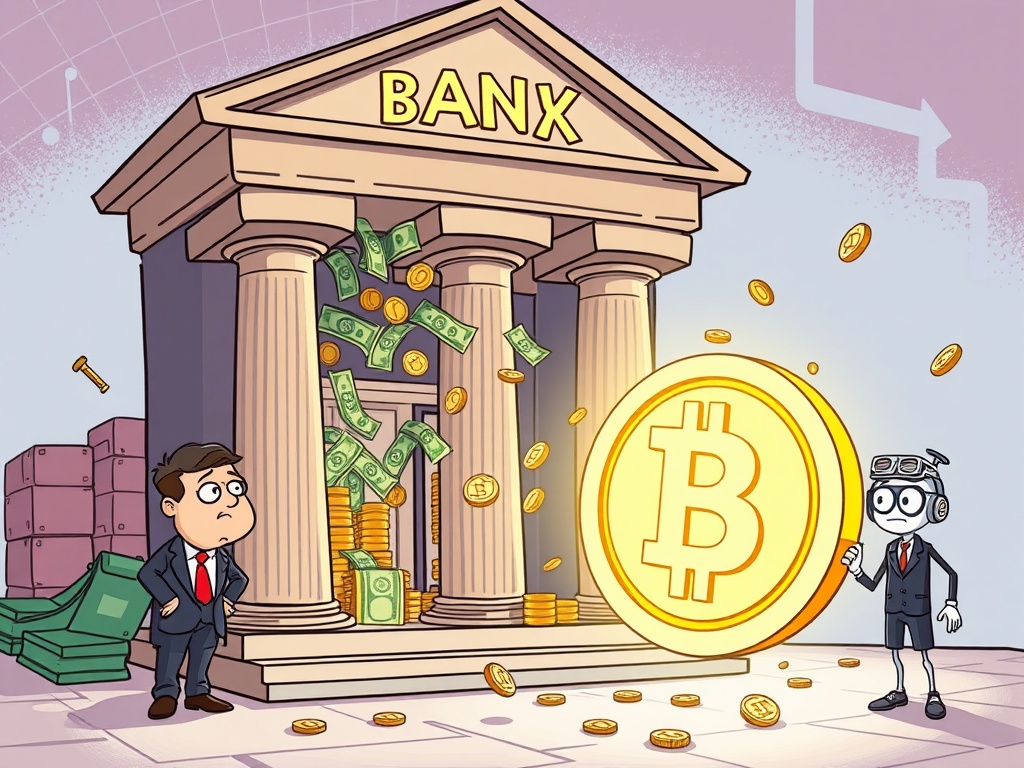Stablecoin Yields: The Looming Threat to Bank Deposits?
0
0

BitcoinWorld

Stablecoin Yields: The Looming Threat to Bank Deposits?
The financial world is buzzing with a critical warning from banking giant Citi. Their expert, Ronit Ghose, has raised a significant concern: the attractive stablecoin yields currently available in the crypto market could trigger a massive outflow of funds from traditional bank deposits. This isn’t just a minor shift; it could lead to higher funding and credit costs for banks, reminiscent of the dramatic money market shifts seen in the 1980s. For anyone invested in the future of finance, understanding this potential disruption is crucial.
What Are Stablecoin Yields and Why Are They a Concern?
Imagine earning a much higher interest rate on your digital dollars than what your traditional savings account offers. That’s essentially the allure of stablecoin yields. Stablecoins are cryptocurrencies designed to maintain a stable value, often pegged to the U.S. dollar. When you “lend” these stablecoins on certain platforms, you can earn substantial interest, or yields. This high earning potential is what worries financial institutions like Citi.
Ghose’s comparison to the 1980s is particularly insightful. Back then, money market funds began offering higher interest rates than traditional bank accounts, causing a significant migration of deposits. Banks had to adapt by raising their own rates, which increased their operational costs and impacted their lending capabilities. A similar scenario could unfold if stablecoin yields continue to attract a growing pool of capital.
Is There a Loophole Allowing High Stablecoin Yields?
You might wonder about regulation. The GENIUS Act, designed to oversee stablecoin issuance, explicitly prohibits stablecoin issuers from offering yields. However, banks argue that a critical loophole exists. This loophole allows crypto exchanges and other platforms, rather than the direct issuers, to offer attractive yields on stablecoins. This distinction creates a grey area where significant amounts of capital could flow, potentially putting at risk an astounding $6.6 trillion in bank deposits.
The implications are profound. If this capital indeed moves, banks would face increased pressure to find alternative funding sources, likely at a higher cost. This could translate into higher loan rates for consumers and businesses, affecting everything from mortgages to small business loans. The debate around this loophole and its impact on stablecoin yields is intensifying.
Banks vs. Crypto: Who Wins the Stablecoin Yields Debate?
The financial industry finds itself divided on this critical issue. Traditional banks are vocal about closing the perceived loophole, viewing it as an unfair advantage for the crypto sector and a potential threat to financial stability. Their arguments often center on:
- Systemic Risk: Unregulated outflows could destabilize traditional banking.
- Level Playing Field: Banks operate under strict regulations, which they argue should apply equally to similar financial products.
- Consumer Protection: Concerns about the risks associated with higher, less regulated stablecoin yields for consumers.
Conversely, the crypto industry strongly opposes any move to restrict these offerings. They argue that closing the loophole would stifle innovation and competition. Their perspective emphasizes:
- Innovation: Stablecoin yields represent a new frontier in financial services, offering efficiency and choice.
- Consumer Benefit: Users gain access to higher returns than traditional savings options.
- Market Evolution: Limiting these yields could hinder the natural progression of digital finance.
This fundamental disagreement underscores the challenge regulators face in balancing established financial stability with emerging technological advancements.
How Does the Treasury View Stablecoin Yields?
The U.S. Treasury Department is also weighing in. Treasury Secretary Scott Bessent, as reported by Cointelegraph, has expressed support for stablecoins. His rationale is that well-regulated stablecoins can help maintain the U.S. dollar’s dominance in the global financial system. This perspective adds another layer of complexity to the discussion. While supporting stablecoins generally, the specific issue of high stablecoin yields and their impact on bank deposits remains a delicate balancing act for regulators.
Regulators face the challenge of fostering innovation while mitigating systemic risks. Finding a middle ground that allows the crypto industry to thrive without destabilizing traditional finance is key. The decisions made regarding stablecoin yields today will undoubtedly shape the financial landscape of tomorrow.
What’s the Potential Impact of Stablecoin Yields on Your Finances?
If stablecoin yields continue to draw significant funds from banks, you might see changes in your own financial life. Banks could offer lower interest rates on savings accounts or charge higher fees to compensate for lost deposits. Conversely, if you participate in the crypto market, you might continue to benefit from attractive yields, albeit with associated risks. Understanding these dynamics helps you make informed financial decisions.
The tension between the innovative potential of stablecoin yields and the stability of traditional banking is a defining financial challenge of our era. As regulators and industry players grapple with these complex issues, the outcome will significantly influence how we save, invest, and manage our money in the years to come.
Summary: Navigating the Future of Finance with Stablecoin Yields
Citi’s stark warning about stablecoin yields highlights a crucial juncture for the global financial system. The debate over regulatory loopholes, the push for innovation, and the need for financial stability are all at play. As this narrative unfolds, both traditional banks and the burgeoning crypto industry must find common ground to ensure a robust and equitable financial future for everyone. The decisions made now will resonate for decades, shaping the very structure of our economy.
Frequently Asked Questions (FAQs)
Q1: What are stablecoin yields?
A1: Stablecoin yields refer to the interest or returns earned by lending out stablecoins, which are cryptocurrencies pegged to a stable asset like the U.S. dollar, on various crypto platforms.
Q2: Why are banks concerned about stablecoin yields?
A2: Banks are concerned that attractive stablecoin yields could cause large amounts of deposits to flow out of traditional banking systems, increasing their funding costs and potentially affecting their ability to lend.
Q3: What is the “loophole” regarding stablecoin yields?
A3: The GENIUS Act prohibits stablecoin issuers from offering yields, but banks argue a loophole allows crypto exchanges and other platforms (not the direct issuers) to offer these yields, bypassing direct regulation.
Q4: How does the U.S. Treasury view stablecoins?
A4: Treasury Secretary Scott Bessent supports stablecoins, believing they can help maintain the U.S. dollar’s global dominance, although the specific issue of high yields and their impact on bank deposits remains a complex regulatory challenge.
Q5: What could be the impact of stablecoin yields on consumers?
A5: Consumers might see changes in traditional bank offerings, such as lower savings rates or higher fees. Conversely, those participating in crypto could continue to benefit from higher yields, albeit with associated risks.
If you found this analysis insightful, please share it with your network! Your engagement helps spread awareness about the critical discussions shaping the future of finance and the impact of stablecoin yields.
To learn more about the latest stablecoin trends, explore our article on key developments shaping the crypto market and its regulatory future.
This post Stablecoin Yields: The Looming Threat to Bank Deposits? first appeared on BitcoinWorld and is written by Editorial Team
0
0
 Manage all your crypto, NFT and DeFi from one place
Manage all your crypto, NFT and DeFi from one placeSecurely connect the portfolio you’re using to start.




